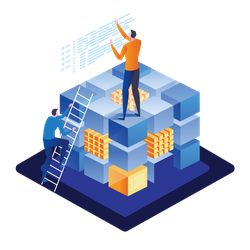Top 5 benefits of using datablocks : according to data engineers
A datablock is a request unit in Nodata, it can be reused, assembled, added up, linked, stacked, ... In the same way as lego bricks.

Advantages of using datablocks for a data engineer

1 / Data blocks reusability:
Each datablock can be used to build different dashboards, so all you have to do is define the data access rules and the calculations to be applied for each datablock just once.
This allows the same logic to be reused in different dashboards.

2/ Data blocks mutualisation:
It is possible to use a datablock that will retrieve data sources with a particular management rule.
It is therefore easy to mutualise the acquisition of data that includes management rules that can be complex and become the source of one or more other datablocks to make dashboards.
This makes maintenance simpler, as only one datablock containing the business rule needs to be modified to positively impact all the dashboards using it.

3/ Data blocks sharing:
It is possible for a company employee to work on extracting data including complex business rules and make it usable by other employees in a simplified way.
This facilitates the sharing of data initiatives within the company's teams.

4/ Data blocks Multisource:
Each datablock can be attached to its own data source, so the datablock assembly can assemble different data sources.
This makes it possible to cross-reference data from different sources.

5/ Data blocks performance:
The business rules of a datablock can be executed:
- Either by the source database
- Either by an intermediate database
- Or by the device that displays the dashboard
This combination can be distributed over the same datablock stack.
This makes it possible to distribute the computational loads throughout the data path, allowing an improvement in performance at constant capacity.
(see webinar on edge computing)
Conclusion :
Datablocks are therefore a modern and innovative version of data management.
All these advantages make using datablocks quite handy and certain tasks easier.
Why Nodata?
Datablocks technology coupled with version management in Nodata and its innovative architecture makes it possible to facilitate data administration within organizations.